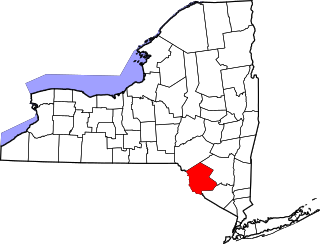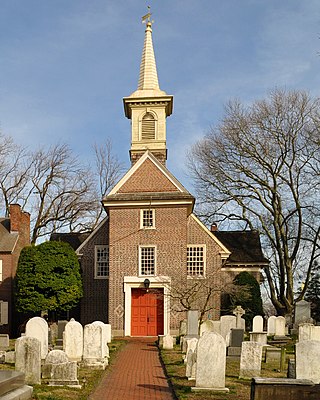
Wilmington station, also known as the Joseph R. Biden, Jr., Railroad Station, is a passenger rail station in Wilmington, Delaware. It serves nine Amtrak train routes and is part of the Northeast Corridor. It also serves SEPTA Regional Rail commuter trains on the Wilmington/Newark Line as well as DART First State local buses and Greyhound Lines intercity buses.

Boathouse Row is a historic site which is located in Philadelphia, Pennsylvania, on the east bank of the Schuylkill River just north of the Fairmount Water Works and the Philadelphia Museum of Art. It consists of a row of fifteen boathouses housing social and rowing clubs and their racing shells. Each of the boathouses has its own history, and all have addresses on both Boathouse Row and Kelly Drive.

Torresdale, also formerly known as Torrisdale, is a neighborhood in the Far Northeast section of Philadelphia, Pennsylvania, United States. Torresdale is located along the Delaware River between Holmesburg and Bensalem Township in neighboring Bucks County.

List of the National Register of Historic Places listings in Sullivan County, New York

The architecture of Philadelphia is a mix of historic and modern styles that reflect the city's history. The first European settlements appeared within the present day borders of Philadelphia, Pennsylvania in the 17th century with most structures being built from logs. By the 18th century, brick structures had become common. Georgian and later Federal style buildings dominated much of the cityscape. In the first half of the 19th century, Greek revival appeared and flourished with architects such as William Strickland, John Haviland, and Thomas U. Walter. In the second half of the 19th century, Victorian architecture became popular with the city's most notable Victorian architect being Frank Furness.
The New Jersey Register of Historic Places is the official list of historic resources of local, state, and national interest in the U.S. state of New Jersey. The program is administered by the New Jersey's state historic preservation office within the New Jersey Department of Environmental Protection.

This is a list of the National Register of Historic Places listings in Center City, Philadelphia.

The Abrams Building was located at South Pearl Street and Hudson Avenue in Albany, New York, United States. It was a brick commercial building constructed in the 1880s. In 1980 it was listed on the National Register of Historic Places.

There are 75 properties listed on the National Register of Historic Places in Albany, New York, United States. Six are additionally designated as National Historic Landmarks (NHLs), the most of any city in the state after New York City. Another 14 are historic districts, for which 20 of the listings are also contributing properties. Two properties, both buildings, that had been listed in the past but have since been demolished have been delisted; one building that is also no longer extant remains listed.

The Architecture of Buffalo, New York, particularly the buildings constructed between the American Civil War and the Great Depression, is said to have created a new, distinctly American form of architecture and to have influenced design throughout the world.

Clifton-Metropolitan Hotel was a historic building located in downtown Davenport, Iowa, United States. The property was listed on the National Register of Historic Places in 1983. It has since been torn down and it was delisted from the National Register in 1997. The site on the corner of Main Street and River Drive, along with the neighboring site of the former Schauder Hotel, is now a public parking structure.

Upper Roxborough Historic District is a national historic district located in Philadelphia and Whitemarsh Township, Montgomery County, Pennsylvania. It encompasses 108 contributing buildings, 23 contributing sites, and 18 contributing structures in Upper Roxborough. The district includes a number of small scale farm and industrial workers' housing, estate houses, mill-owners' dwellings, and farm buildings. Notable buildings include the Shawmont Railroad Station (1834), Miquon Station designed by Frank Furness (1910), Riverside Paper Mills, Hagy's Mill ruin, St. Mary's Church, and "Fairview" and other buildings on the grounds of the Schuylkill Center for Environmental Education. The Roxborough Pumping Station was also part of the district, but it was demolished in 2011 after sitting abandoned for over fifty years.

Horace Jayne House (1895) is an architecturally significant building designed by architect Frank Furness in Philadelphia, Pennsylvania, United States. It is located at the southwest corner of 19th and Delancey Streets, about a block south of Rittenhouse Square.
Furness & Evans was a Philadelphia architectural partnership, established in 1881, between architect Frank Furness and his former chief draftsman, Allen Evans. In 1886, other employees were made partners, and the firm became Furness, Evans & Company. George Howe worked in the firm and later became a partner at Mellor & Meigs, another Philadelphia firm.

Gibraltar, located at 2505 Pennsylvania Avenue in Wilmington, Delaware, is a country estate home dating from c. 1844 that is listed on the National Register of Historic Places. It takes its name from the Rock of Gibraltar, alluding to the high rocky outcrop on which the house was built. It is located just inside Wilmington's city limits and originally stood at the center of a much larger estate which has over time been reduced to the present area of about a city block in size. The house was originally built by John Rodney Brincklé and inherited by his brother's wife and children, before being bought in 1909 by Hugh Rodney Sharp, who was linked to the Du Pont family through marriage and work. Sharp expanded and remodeled the house, as well as commissioning the pioneering female landscape designer Marian Cruger Coffin to lay out the gardens.

The Knickerbocker and Arnink Garages were two attached stone buildings located on Hudson Avenue in central Albany, New York, United States. Both were built in the early 20th century; the Knickerbocker garage was added to the Arnink garage 12 years after it was built. In 1980, they were listed on the National Register of Historic Places; nine years later they were both demolished and delisted.

The Conro Fiero House, also known as Woodlawn Acres and latterly as the Mon Desir restaurant, was a revival-style Tudor mansion built in 1910 by Conro Fiero. Originally listed on the National Register of Historic Places on December 9, 1981, it was delisted on June 1, 2011, following its destruction by fire.

Lindenshade(Wallingford, Pennsylvania), was the Wallingford country house and farm of Shakespearean scholar Horace Howard Furness (1833–1912) and family. The house's design is attributed to his brother, architect Frank Furness. It was expanded numerous times, and demolished in 1940. Two other buildings from the property survive. The Helen Kate Furness Library, a memorial to HHF's wife, was built at the west end of the property in 1916.

Point Breeze was an estate in Bordentown, New Jersey. It was the home of Joseph Bonaparte, the brother of Napoleon Bonaparte, from 1816 to 1839.

H. Edwards Ficken (1852-1929) was an English American architect in practice in New York City.























